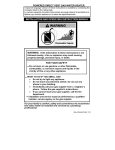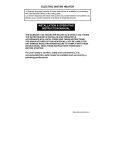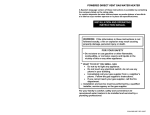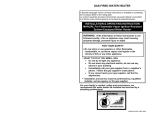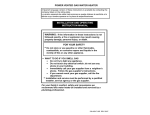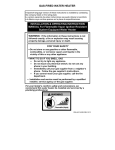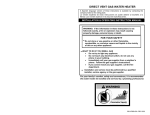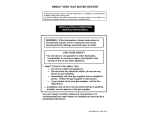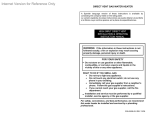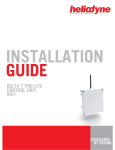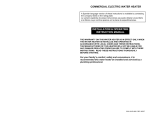Download Bradford White THROUGH-THE-WALL GAS WATER HEATER Specifications
Transcript
THROUGH-THE-WALL COMBINATION GAS WATER HEATER A Spanish language version of these instructions is available by contacting the company listed on the rating plate. La version espanola de estas instrucciones se puede obtener al escribirle a la fabrica cuyo nombre aparece en la placa de especificaciones. WARNING: If the information in these instructions is not followed exactly, a fire or explosion may result causing property damage, personal injury or death. FOR YOUR SAFETY Do not store or use gasoline or other flammable, combustible, or corrosive vapors and liquids in the vicinity of this or any other appliance. WHAT TO DO IF YOU SMELL GAS • Do not try to light any appliance. • Do not touch any electrical switch; do not use any phone in your building. • Immediately call your gas supplier from a neighbor’s phone. Follow the gas supplier's instructions. • If you cannot reach your gas supplier, call the fire department. Installation and service must be performed by a qualified installer, service agency or the gas supplier. 238-42968-00E REV 05/06 TABLE OF CONTENTS GENERAL INFORMATION................................................................................................ page 3 INSTALLATION. ................................................................................................................ Locating The Water Heater .................................................................................. Minimum Clearances............................................................................................. Venting....................................................................................................................... Specifications for 48 Gal, 65,000 BTU input (189.3 L, 19.1 kW/Hr) 75 Gal, 75,000 BTU input (283.9 L, 22.0 kW/Hr)................................ 4 4 7 7 Combustion Air Supply .......................................................................................... Water Connections................................................................................................. Gas Connections ..................................................................................................... Electrical Connections........................................................................................... Wiring Diagram for 48 Gal, 65,000 BTU input (189.3 L, 19.1 kW/Hr) 75 Gal, 75,000 BTU input (283.9 L, 22.0 kW/Hr)................................ 15 17 20 21 GENERAL OPERATION.................................................................................................... Lighting and Shutdown Instructions .................................................................. Thermostat Adjustment ........................................................................................ Burner Flame Check............................................................................................... 23 24 25 26 MAINTENANCE.................................................................................................................. 27 PARTS LIST DRAWING................................................................................................... 30 PARTS LIST....................................................................................................................... 31 INSTALLATION INSTRUCTIONS FOR POTABLE WATER AND SPACE HEATING............................................................................................................................. 31 9 22 CONGRATULATIONS! You have just purchased one of the finest water heaters on the market today! This installation, operation and instruction manual will explain in detail the installation and maintenance of your new Through-The-Wall Gas Water Heater. We strongly recommend that you contact a plumbing professional for the installation of this water heater. We require that you carefully read this manual, as well as the enclosed warranty, and refer to it when questions arise. If you have any specific questions concerning your warranty, please consult the plumbing professional from whom your water heater was purchased. For your records we recommend that you write the model, serial number and installation date of your water heater in the maintenance section in the back of this manual. This manual should be kept with the water heater. 2 GENERAL INFORMATION This gas-fired combination water heater’s design is certified by CSA International under the American National Standard Z21.10.1 - (as indicated on the rating plate) and CSA 4.1-M - (as indicated on the rating plate). This water heater must be installed in accordance with local codes or, in the absence of local codes, the National Fuel Gas Code, ANSI Z223.1-Latest Edition) and/or in Canada CAN/CGA B149 Installation Codes (Latest Editions). The warranty for this water heater is in effect only when the water heater is installed, adjusted, and operated in accordance with these Installation and Operating Instructions. The manufacturer will not be held liable for any damage resulting from alteration and/or failure to comply with these instructions. This water heater is not design certified for installation in a mobile home. Such an installation may create a hazardous condition and will nullify the warranty. CAUTION Incorrect operation of this appliance may create a hazard to life and property and will nullify the warranty. Do not use this appliance if any part has been submerged in water. You should contact a qualified service technician to inspect the appliance and to replace any part of the control system including the combination gas control which has been submerged in water. DANGER Do not store or use gasoline or other flammable, combustible, or corrosive vapors and liquids in the vicinity of this or any other appliance. IMPORTANT Before proceeding, please inspect the water heater and its components for possible damage. DO NOT install any damaged components. If damage is evident then please contact the supplier where the water heater was purchased or the manufacturer listed on the rating plate for replacement parts. Make sure that you check the rating plate and combination gas control on the water heater to be certain that the type of gas being supplied corresponds with the marking on the rating plate and combination gas control. 3 General Information continued- A sacrificial anode is used to extend tank life. The removal of this anode, for any reason, will nullify the warranty. In areas where water is unusually active, an odor may occur at the hot water faucet due to a reaction between the sacrificial anode and the impurities in the water. If this should happen, an alternative anode may be purchased from the supplier that installed this water heater. This will minimize the odor while protecting the tank. Additionally, the water heater should be flushed with appropriate dissolvers to eliminate any bacteria. INSTALLATION Locating The Water Heater WARNING Water heaters are heat producing appliances. To avoid damage or injury, do not store materials against the water heater or vent-air intake system. Use proper care to avoid unnecessary contact (especially by children) with the water heater and vent-air intake components. UNDER NO CIRCUMSTANCES SHALL FLAMMABLE MATERIALS, SUCH AS GASOLINE OR PAINT THINNER BE USED OR STORED IN THE VICINITY OF THIS WATER HEATER, VENT-AIR INTAKE SYSTEM OR IN ANY LOCATION FROM WHICH FUMES COULD REACH THE WATER HEATER OR VENT-AIR INTAKE SYSTEM. This water heater MUST be installed indoors out of the wind and weather. DO NOT install the water heater in any location where gasoline or flammable vapors are likely to be present. Water Heaters in residential garages shall be installed so that all burner(s) and burner ignition device(s) are located not less than 18 inches (46 cm) above the floor and shall be located, or protected, to avoid physical damage. For other installations refer to local codes. In the absence of local codes, the water heater shall be installed in compliance with the National Fuel Gas Code, ANSI Z223.1 - (Latest Edition) and/or in Canada, CAN/CGA B149 Installation Codes (Latest Editions). The location of this water heater is of the utmost importance. Before installing this water heater, read the installation section of these instructions. After reading these installation and operating instructions, select a location for the water heater where the floor is level and is easily accessible to gas and water supply lines. DO NOT locate the water heater where water lines could be subjected to freezing temperatures. Make sure the cold water pipes are not located directly above the gas control so that condensate during humid weather does not drip on the controls. 4 Installation (Locating The Water Heater) continued- Note: For California installation this water heater must be braced, anchored, or strapped to avoid falling or moving during an earthquake. See instructions for correct installation procedures. Instructions may be obtained from California Office of the State Architect, 400 P Street, Sacramento, CA 95814. Water heater corrosion and component failure can be caused by the heating and breakdown of airborne chemical vapors. Examples of some typical compounds that are potentially corrosive are: spray can propellants, cleaning solvents, refrigerator and air conditioning refrigerants, swimming pool chemicals, calcium and sodium chloride, waxes and process chemicals. These materials are corrosive at very low concentration levels with little or no odor to reveal their presence. NOTE: DAMAGE TO THE WATER HEATER CAUSED BY EXPOSURE TO CORROSIVE VAPORS IS NOT COVERED BY THE WARRANTY. DO NOT OPERATE THE WATER HEATER IF EXPOSURE HAS OR WILL OCCUR. DO NOT STORE ANY POTENTIALLY CORROSIVE COMPOUNDS IN THE VICINITY OF THE WATER HEATER. WARNING Liquefied petroleum gases/propane gas are heavier than air and will remain at floor level if there is a leak. Basements, crawl spaces, closets and areas below ground level will serve as pockets for accumulation of leaking gas. Before lighting, smell all around the appliance area for gas. Be sure to smell next to the floor. IF YOU SMELL GAS: • Do not try to light any appliance. • Do not touch any electric switch; do not use any telephone in your building. • Immediately call your gas supplier from a neighbor’s telephone. Follow the gas supplier’s instructions. • If you cannot reach your gas supplier, call the fire department. DO NOT OPERATE APPLIANCE UNTIL THE LEAKAGE IS CORRECTED! 5 6 Installation (Locating The Water Heater) continued- WARNING DO NOT ATTEMPT TO LIGHT ANY GAS APPLIANCE IF YOU ARE NOT CERTAIN OF THE FOLLOWING: • Liquefied petroleum gases/propane gas and natural gas have an odorant added by the gas supplier that aids in the detection of the gas. • Most people recognize this odor as a “sulfur” or “rotten egg” smell. • Other conditions, such as “odorant fade” can cause the odorant to diminish in intensity, or ”fade”, and not be as readily detectable. • If you have a diminished sense of smell, or are in any way unsure of the presence of gas, immediately contact your gas supplier from a neighbor’s telephone. • Gas detectors are available. Contact your gas supplier, or plumbing professional, for more information. The water heater must be located close enough to the outside wall to keep the venting distance within the maximum distance described in the installation instructions. Read the venting section in this installation instruction manual before locating the water heater. This water heater must be located in an area where leakage of the tank or water line connections and the combination temperature and pressure relief valve will not result in damage to the area adjacent to the water heater or to lower floors of the structure. When such locations cannot be avoided, a suitable drain pan adequately piped for proper drainage, must be installed under the water heater. The pan must not restrict combustion air flow. The drain pan must have a minimum length and width of at least 4 in. (10.2 cm) greater than the diameter of the water heater and must not restrict proper combustion air flow to the water heater. The drain pan, as described above, can be purchased from your plumbing professional. The drain pan must be piped to an adequate drain. The piping must be at least 3/4 inch (1.9 cm) in diameter and pitched for proper drainage. It is recommended that a minimum clearance of four (4) inches (10.2 cm) be provided on the side of the water heater for servicing and maintenance of the combination temperature and pressure relief valve. 7 Installation (Minimum Clearances) continued- Minimum Clearances WARNING Failure to adhere to these installation and operating instructions may create a hazard to life and property and will nullify the warranty. This installation shall allow access to the front of the water heater and adequate clearance shall be provided for servicing and operating this water heater. The water heater may be installed on either a combustible or non-combustible floor. If the water heater is to be installed directly on carpeting, it shall be installed on top of a metal or wood panel extending beyond the full width and depth of the appliance by at least three (3) inches (7.6 Cm) in any direction or, if the appliance is to be installed in an alcove or closet, the entire floor shall be covered by the panel. The minimum clearances to combustibles for this water heater is: zero (0) inch (0 cm) from the sides and rear, five (5) inches (12.7 cm) from the front of the jacket, zero (0) inch (0 cm) from the vent connector and fifteen (15) inches (38.1 cm) from the jacket top. Venting WARNING The venting system must be installed properly following all local codes or in the absence of local codes, the latest edition of the National Fuel Gas Code (ANSI Z223.1- latest edition), or in Canada, The Natural Gas and Propane Installation Code (B149.1-00 latest edition). Failure to properly install the venting system could result in property damage, personal injury, or death. Figure 1. Vent Terminal Clearances (Other than Direct Vent or “Power Vented” Installations) 8 Installation (Venting) continuedCanadian Installations 1 US Installations 2 Clearance above grade, veranda, porch, deck or balcony Clearance to widow or door that may be opened 12 inches (30 cm) 12 inches (30 cm) *b *b *b E= Clearance to permanently closed widow Vertical clearance to ventilated soffit located above the terminal within a horizontal distance of 2 feet (61 cm) from the center line of the terminal Clearance to unventilated soffit 12 inches (30 cm) 4 feet (1.2 m) below or to the side of opening; 12 inches (30 cm) above opening *b *b *b F= Clearance to outside corner *b *b G= Clearance to inside corner *b *b H= Clearance to each side of center line extended above meter/regulator assembly *b I= Clearance to service regulator vent outlet or oil tank vent Clearance to non-mechanical air supply inlet to building or the combustion air inlet to any other appliance Clearance to a mechanical air supply inlet 3 feet (91 cm) within a height 15 feet (4.6 m) above the meter/regulator assembly 36 inches (91 cm) 12 inches (30 cm) A= B= C= D= J= K= 6 feet (1.83 m) L= *b 4 feet (1.2m) below or to side of opening; 12 inches (30 cm) above opening. 3 feet (91 cm) above if within 10 feet horizontally 7 feet (2.13 m)† Clearance above paved sidewalk 7 feet or paved driveway located on (2.13 m)† public property M= Clearance under a veranda, porch, 12 inches (30 *b deck, or balcony cm) ‡ 1 In accordance with the current CAN/CGA-B149 Installation Codes . 2 In accordance with the current ANSI Z223.1-(Latest edition)/NFPA 54 National Fuel Gas Code. † A vent shall not terminate directly above a sidewalk or paved driveway that is located between two single-family dwellings and serves both dwellings. ‡ Permitted only if a veranda, porch, deck or balcony is fully open on a minimum of two sides beneath the floor. *a) A minimum clearance value determined by testing in accordance with section 2.20. *b) “Clearance in accordance with local installation codes and the requirements of the gas supplier”. The vent system must terminate so that proper clearances are maintained as cited in local codes or the latest edition of the National Fuel Gas Code, ANSI Z223.1.73.4e and 7.8a, b as follows: 1. Do not terminate near soffit vents or crawl space or other area where condensate or vapor could create a nuisance or hazard or cause property damage. 9 2. 3. 4. Do not terminate the exhaust vent terminal where condensate or vapor could cause damage or could be detrimental to the operation of regulators, relief valves, or other equipment. Do not terminate the exhaust vent terminal over public area or walkways where condensate or vapor can cause nuisance or hazard. The vent shall terminate a minimum of 12 inches above expected snowfall level to prevent blockage of vent termination. 10 Installation (Venting) continuedVent pipes serving power vented appliances are classified by building codes as “vent connectors”. Required clearances from combustible materials must be provided in accordance with information in this manual under LOCATION OF WATER HEATER and CLEARANCES, and with National Fuel Gas Code and local codes. Part I - Venting Specifications for: 48 Gallon, 65,000 BTU input (189.3 L, 19.1 kW/Hr) 75 Gallon, 75,000 BTU input (283.9 L, 22.0 kW/Hr) This water heater is a power vented appliance and is designed to vent its products of combustion through 3” (7.6 cm) or 4” (10.2 cm) diameter Schedule 40 PVC pipe to the outdoors. This water heater may be either vented through the wall or vertically through the roof. The blower outlet is designed to fit 3” (7.6 cm) diameter PVC pipe. Use a 3” (7.6 cm) to 4” (10.2 cm) reducer to connect to the vent outlet when using 4” (10.2 cm) PVC. Seal the joint between the PVC pipe and the blower outlet collar with RTV sealant (See figure 2). Table 1 lists the maximum vent lengths for this water heater using 3” (7.6 cm) PVC. If possible, locate the water heater so that the venting length and number of elbows are kept to the minimum distance necessary to reach the outside. If the installation requires venting lengths that exceed the lengths listed for 3” (7.6 cm) PVC in Table 1, then use 4” (10.2 cm) PVC for the vent connector. Table 2 lists the venting distances allowed with 4” (10.2 cm) diameter PVC pipe. When venting with 4” (10.2 cm) PVC, use a 4” (10.2 cm) to 3” (7.6 cm) reducer to exit through the building wall with 3” (7.6 cm) PVC. Use 3” (7.6 cm) vent terminal supplied with the water heater to terminate on the outside of the building. If the length of the 3” (7.6 cm) PVC needed to go through the wall is greater than 14” (35.5 cm), use 4” (10.2 cm) to go through the wall and reduce to 3” (7.6 cm) PVC immediately after exiting the outside wall. Refer to the venting illustrations on the following pages. Make sure the vent pipe terminal elbow fitting is at least 1” (2.5 cm) away from the edge of the wall. TABLE 1 - VENT CONNECTOR LENGTHS FOR 3” (7.6 cm) DIAMETER PVC Terminating # of 90° Elbows Maximum (excluding vent Length terminal) Through the Wall 1 40 ft (12 m) Through the Wall 2 35 ft (10.5 m) Through the Wall 3 30 ft (9 m) Through the Wall 4 25 ft (7.5 m) Through the Roof 1 40 ft (12 m) Through the Roof 2 35 ft (10.5 m) Through the Roof 3 30 ft (9 m) Through the Roof 4 25 ft (7.5 m) 11 Minimum Length 2 ft (.6 m) 3 ft (.9 m) 5 ft (1.5 m) 8 ft (2.4 m) 2 ft (.6 m) 3 ft (.9 m) 5 ft (1.5 m) 8 ft (2.4 m) Installation (Venting) continued- TABLE 2-VENT CONNECTOR LENGTHS FOR 4” (10.1 cm) DIAMETER PVC Terminating # of 90° Elbows Maximum Minimum (excluding vent Length Length terminal) Through the Wall 1 70 ft (21.5 m) 2 ft (.6 m) Through the Wall 2 65 ft (20 m) 3 ft (.9 m) Through the Wall 3 60 ft (18.5 m) 5 ft (1.5 m) Through the Wall 4 55 ft (17 m) 8 ft (2.4 m) Through the Wall 5 50 ft (15 m) 12 ft (3.5 m) Through the Roof 1 70 ft (21.5 m) 2 ft (.6 m) Through the Roof 2 65 ft (20 m) 3 ft (.9 m) Through the Roof 3 60 ft (18.5 m) 5 ft (1.5 m) Through the Roof 4 55 ft (17 m) 8 ft (2.4 m) Through the Roof 5 50 ft (15 m) 12 ft (3.5 m) NOTE: When using 4” (10.1 cm) PVC, use a 4” (10.1 cm) to 3” (7.6 cm) reducer and exit the building wall with 3” (7.6 cm) PVC using the 3” (7.6 cm) 90° vent terminal supplied. Two 45° elbows are equivalent to one 90° elbow. Figure 2 12 Installation (Venting) continued- IMPORTANT All of the Venting connections must be leak checked with a soap solution upon initial start up of the water heater. Any leaks shall be repaired before continuing operation of the water heater. NOTE: ABS or CPVC pipes may be substituted for PVC pipe. Do not mix ABS and PVC pipe in the same installation. THROUGH THE WALL VENTING: Cut a 3 1/2 in. (8.9 cm) diameter hole in the wall at the point where the vent connector is going to pass through the wall. Use the proper cement to secure the 90° vent terminal provided with the water heater to the vent connector. The distance between the edge of the 90° vent terminal and the exterior wall (see Figure 3) shall be 1 in. (2.5 cm). Use the proper cement and assembly procedures to secure the vent connector joints between the terminal and the blower outlet. Provide support brackets for every 3 feet (.91 m) of horizontal vent. Figure 3 13 Installation (Venting) continued- THROUGH THE ROOF VENTING: (VERTICAL VENTING) Cut the necessary holes through the roof and ceiling and install the vent connector as shown in Figure 4A. Make sure that the installation meets the local codes and/or The National Fuel Gas Code ANSI Z223.1 (Latest Edition) or CGA/CAN B149 Installation Code. Installations having long vertical runs through attics or long horizontal runs through unheated crawl spaces may accumulate condensate. In order to prevent condensate from draining back into the blower, a drain tee and condensate trap may be installed in the horizontal vent as close as practical to the blower vent connection (See Figure 4B). Figure 4A Figure 4B 14 Installation (Venting) continued- THROUGH THE WALL VENTING WITH LOW GROUND CLEARANCE: When venting cannot exit through the wall at a height greater than or equal to 12” (30.5 cm) from the ground, then the installation shall be modified as shown below (see Figure 5). Refer to Table 3 for maximum venting lengths using 3” (7.6 cm) PVC or Table 4 for maximum lengths using 4” (10.1 cm) PVC. Figure 5 15 Installation (Venting) continued- TABLE 3 3” (7.6 cm) PVC VENT CONNECTOR LENGTHS FROM INSIDE WALL FOR LOW GROUND CLEARANCE INSTALLATIONS Terminating # of Maximum Minimum Elbows Length Length (2) 90° Elbows with (1) 90° Elbow 1 30 ft (9 m) 5 ft (1.5 m) (2) 90° Elbows with (1) 90° Elbow 2 25 ft (7.6 m) 6 ft (2 m) (2) 90° Elbows with (1) 90° Elbow 3 20 ft (6.1 m) 8 ft (2.5 m) (2) 90° Elbows with (1) 90° Elbow 4 15 ft (4.6 m) 10 ft (3 m) TABLE 4 4” (10.1 cm) VENT CONNECTOR LENGTHS FROM INSIDE WALL FOR LOW GROUND CLEARANCE INSTALLATIONS Terminating (Reduce 4” to 3”) #of Maximum Minimum (Reduce 10.1 cm to 7.6 cm) Elbows Length Length (2) 90° Elbows with (1) 90° Elbow 1 50 ft (15 m) 10 ft (3 m) (2) 90° Elbows with (1) 90° Elbow 2 45 ft (14 m) 12 ft (3.7 m) (2) 90° Elbows with (1) 90° Elbow 3 40 ft (12 m) 15 ft (4.6 m) (2) 90° Elbows with (1) 90° Elbow 4 35 ft (10.5 m) 18 ft (5.5 m) (2) 90° Elbows with (1) 90° Elbow 5 30 ft (9 m) 22 ft (6.7 m) HIGH ALTITUDE INSTALLATIONS FOR ELEVATIONS OVER 3,000 FEET (914.5 m) ABOVE SEA LEVEL The capacity of the induced draft blower declines with increasing altitude due to a reduction in the air density. In order to assure safe and reliable performance of the water heater, the following guidelines must be followed. Refer to the venting tables below for maximum distances for the altitudes in your location. TABLE 5 - HIGH ALTITUDE LENGTHS Altitude above sea level 0-3,000 ft (0-914.5m) over 3,00010,000 ft (914.5-3048m) Maximum venting length reduction from tables 1 & 3 No reduction in vent length required No reduction in vent length required Maximum venting length reduction from tables 2 & 4 No reduction in vent length required No reduction in vent length required 16 Modifications to water heater None Requires high altitude kit. Call the supplier or the manufacturer Combustion Air Supply WARNING Liquefied petroleum gases/propane gas are heavier than air and will remain at floor level if there is a leak. Basements, crawl spaces, closets and areas below ground level will serve as pockets for accumulation of leaking gas. Before lighting, smell all around the appliance area for gas. Be sure to smell next to the floor. IF YOU SMELL GAS: • Do not try to light any appliance. • Do not touch any electric switch; do not use any telephone in your building. • Immediately call your gas supplier from a neighbor’s telephone. Follow the gas supplier’s instructions. • If you cannot reach your gas supplier, call the fire department. DO NOT OPERATE APPLIANCE UNTIL LEAKAGE IS CORRECTED! IMPORTANT The flow of combustion and ventilating air must not be obstructed. Provide adequate air for combustion and ventilation. An insufficient supply of air will cause recirculation of combustion products resulting in air contamination that may be hazardous to life. Such a condition often will result in a yellow, luminous burner flame, causing carboning or sooting of the combustion chamber, burners and flue tubes with possible damage to the heater. When an exhaust fan is installed in the same room with a heater, sufficient openings for air must be provided in the walls. Undersized openings will cause air to be drawn into the room through the chimney, causing recirculation of combustion products. Unconfined Spaces In unconfined spaces in buildings, infiltration may be adequate to provide air for combustion, ventilation and dilution of flue gases. However, in buildings of tight construction (for example, weather stripping, heavily insulated, caulked, vapor barrier, etc.), additional air may need to be provided using the methods described above under CONFINED SPACES: All Air From Outdoors or SPECIALLY ENGINEERED INSTALLATIONS. Confined Spaces Confined spaces are spaces defined as having less than 50 ft.3/1000 BTU (15 m3/0.29 kw) per hour. 17 Installation (Combustion Air Supply) continued- All Air From Inside the Building: The confined space shall be provided with two permanent openings communicating directly with an additional room(s) of sufficient volume so that the combined volume of all spaces meets the criteria for an unconfined space. The total input of all gas utilization equipment installed in the combined space shall be considered in making this determination. Each opening shall have a minimum free area of 1 square inch per 1000 BTU (2.54 cm2/0.29 kw) per hour of the total input rating of all gas utilization equipment in the confined space, but not less than 100 square inches (254 cm2). One opening shall be within 12 inches (31 cm) of the top and one within 12 inches (31 cm) of the bottom of the enclosure. All Air From Outdoors: The confined space shall be provided with two permanent openings, one commencing within 12 inches (31 cm) of the top and one commencing within 12 inches (31 cm) from the bottom of the enclosure. The openings shall communicate directly, or by ducts, with the outdoors or spaces (crawl or attic) that freely communicate with the outdoors. 1. 2. 3. 4. When directly communicating with the outdoors, each opening shall have a minimum free area of 1 square inch per 4000 BTU (2.54 cm2/1.2 kw) per hour of total input rating of all equipment in the enclosure. When communicating with the outdoors through vertical ducts, each opening shall have a minimum free area of 1 square inch per 4000 BTU (2.54 cm2/1.2 kw) per hour of total input rating of all equipment in the enclosure. When communicating with the outdoors through horizontal ducts, each opening shall have a minimum free area of 1 square inch per 2000 BTU (2.54 cm2/0.6 kw) per hour of total input rating of all equipment in the enclosure. When ducts are used, they shall be of the same cross-sectional area as the free area of the openings to which they connect. The minimum dimension of rectangular air ducts shall be not less than 3 inches (7.5 cm). Specially Engineered Installations The requirements noted under CONFINED SPACES above shall not necessarily govern when special engineering, approved by the authority having jurisdiction, provides an adequate supply of air for combustion, ventilation, and dilution of flue gases. 18 Water Connections Note: BEFORE PROCEEDING WITH THE INSTALLATION, CLOSE THE MAIN WATER SUPPLY VALVE. After shutting off the main water supply, open a faucet to relieve the water line pressure to prevent any water from leaking out of the pipes while making the water connections to the water heater. After the pressure has been relieved, close the faucet. The COLD water inlet and HOT water outlet are identified on the top of the water heater. The fittings at the cold water inlet and hot water outlet are dielectric waterway fittings with 3/4” NPT male thread. Make the proper plumbing connections between the water heater and the plumbing system to the house. Install a shut-off valve in the cold water supply line. CAUTION If sweat fittings are to be used DO NOT apply heat to the nipples on top of the water heater. Sweat the tubing to the adapter before fitting the adapter to the water connections. It is imperative that heat is not applied to the nipples containing a plastic liner. WARNING FAILURE TO INSTALL AND MAINTAIN A NEW, LISTED 3/4” X 3/4” TEMPERATURE AND PRESSURE RELIEF VALVE WILL RELEASE THE MANUFACTURER FROM ANY CLAIM WHICH MIGHT RESULT FROM EXCESSIVE TEMPERATURE AND PRESSURES. If this water heater is installed in a closed water supply system, such as the one having a back-flow preventer in the cold water supply, provisions shall be made to control thermal expansion. DO NOT operate this water heater in a closed system without provisions for controlling thermal expansion. Your water supplier or local plumbing inspector should be contacted on how to control this situation After installation of the water lines, open the main water supply valve and fill the water heater. While the water heater is filling, open several hot water faucets to allow air to escape from the water system. When a steady stream of water flows through the faucets, close them and check all water connections for possible leaks. NEVER OPERATE THE WATER HEATER WITHOUT FIRST BEING CERTAIN IT IS FILLED WITH WATER. 19 WARNING For protection against excessive temperatures and pressure, install temperature and pressure protective equipment required by local codes, but not less than a combination temperature and pressure relief valve certified by a nationally recognized testing laboratory that maintains periodic inspection of production of listed equipment or materials as meeting the requirements of the Standard for Relief Valves and Automatic Gas Shutoff Devices for Hot Water Supply Systems, ANS Z21.22 or the Standard CAN1-4.4. Temperature and Pressure and the Standard CAN1-4.4, Temperature, Pressure, Temperature and Pressure Relief Valves and Vacuum Relief Valves. The combination temperature and pressure relief valve shall be marked with a maximum set pressure not to exceed the maximum working pressure of the water heater. The combination temperature and pressure relief valve shall also have an hourly rated temperature steam BTU discharge capacity not less than the hourly rating of the water heater. Install the combination temperature and pressure relief valve into the opening provided and marked for this purpose on the water heater. Note: Some models may already be equipped or supplied with a combination temperature and pressure relief valve. Verify that the combination temperature and pressure relief valve complies with local codes. If the combination temperature and pressure relief valve does not comply with local codes, replace it with one that does. Follow the installation instructions above on this page. Install a discharge line so that water discharged from the combination temperature and pressure relief valve will exit within six (6) inches (15.2 cm) above, or any distance below the structural floor and cannot contact any live electrical part. The discharge line is to be installed to allow for complete drainage of both the combination temperature and pressure relief valve and the discharge line. The discharge opening must not be subjected to blockage or freezing. DO NOT thread, plug or cap the discharge line. It is recommended that a minimum clearance of four (4) inches (10.2 cm) be provided on the side of the water heater for servicing and maintenance of the combination temperature and pressure relief valve. Do not place a valve between the combination temperature and pressure relief valve and the tank. 20 Installation (Water Connections) continued- WARNING Hydrogen gas can be produced in an operating water heater that has not had water drawn from the tank for a long period of time (generally two weeks or more). Hydrogen gas is extremely flammable. To prevent the possibility of injury under these conditions, we recommend the hot water faucet to be open for several minutes at the kitchen sink before you use any electrical appliance which is connected to the hot water system. If hydrogen is present, there will be an unusual sound such as air escaping through the pipes as hot water begins to flow. Do not smoke or have open flame near the faucet at the time it is open. This water heater can deliver scalding temperature water at any faucet in the system. Be careful whenever using hot water to avoid scalding injury. Certain appliances such as dishwashers and automatic clothes washers may require increased temperature water. By setting the thermostat on this water heater to obtain the increased temperature water required by these appliances, you may create the potential for scald injury. To protect against injury, you should install an ASSE approved mixing valve in the water system. This valve will reduce point of discharge temperature by mixing cold and hot water in branch supply lines. Such valves are available from the manufacturer of this water heater or a local plumbing supplier. Please consult with a plumbing professional. 21 Gas Connections The gas supply lines must meet all requirements of the National Fuel Gas Code (ANSI Z223.1-Latest Edition), or in Canada CAN/CGA B149.1 Natural Gas Installation Code (Latest Edition) or CAN/CGA B149.2 Propane Installation Code (Latest Edition). The minimum permissible gas supply pressure for the purpose of input adjustment is one (1.0) inch (0.25 kPa) water column above the operating manifold pressure. See the rating plate and gas valve for the manifold pressure and gas type. The maximum permissible gas supply pressure is fourteen (14.0) inches (3.5 kPa) water column for natural gas and liquefied petroleum gases/propane gas. 1. Connect this water heater only to the type of gas (Natural or Propane gas) as shown on the rating plate. Use clean black iron pipe or equivalent material approved by local codes and ordinances. (Dirt and scale from the pipe can enter the gas valve and cause it to malfunction). The inlet gas line must have a minimum length of three (3) inches (7.6 cm) drip leg (sediment trap) installed as close to the water heater’s gas valve as possible. A ground joint union must be installed as close to the water heater as possible in the gas supply line feeding the water heater to permit servicing of the water heater. Compounds used on the threaded joints of the gas piping must be resistant to the action of liquefied petroleum gases/propane gas. DO NOT apply pipe dope to the gas valve inlet and make certain that no pipe dope has become lodged in the inlet screen of the gas valve. Extreme care must be taken to ensure no pipe dope enters the gas valve. Avoid excessive torque when tightening the gas supply line to the gas valve. Excessive torque may result in cracking of the gas valve housing and could create a gas leak. The suggested maximum torque is 31.5 ft. lbs. (4.4 kg-m). WARNING The manufacturer of this water heater will not be liable for any damage or injury caused as a result of a cracked gas inlet as a result of excessive torque. 2. This water heater and its gas connection must be leak tested before placing the water heater in operation. Check for gas leaks with a soap and water solution and a brush or a commercial leak detector fluid. NEVER USE A MATCH OR OPEN FLAME FOR TESTING! CAUTION The water heater and individual shutoff valve must be disconnected from the gas supply piping system during any pressure testing of the system at test pressures in excess of 1/2 psi (3.5 kPa). The water heater must be isolated from the gas supply piping system by closing its manual shutoff valve during any pressure testing of the gas supply system at test pressures equal to or less than 1/2 psi (3.5 kPa). The supply line must be capped when not connected to the water heater. 3. While checking for leaks care must be taken to prevent solution from contacting the electrical connections at the control. If electrical connections at the control 22 become wet, they must be thoroughly dried before attempting to operate the water heater. 23 Electrical Connections All electrical wiring and connections shall be in accordance with the National Electric Code ANSI/NFPA No. 70 (latest edition), or the Canadian Electrical Code C22.1 (latest edition) and any local codes which may apply. The water heater shall be electrically grounded. If a flexible line cord and plug is permitted by local code, then provide a (3) three wire grounding type receptacle within 6 feet (1.9 m) of the water heater and use the flexible cord provided. Do not plug the line cord into a receptacle that can have its power supply interrupted by a switch that is used to turn on and off lights. If wiring in conduit is required, remove the flexible line cord from the jacket and install a 1/2" electrical conduit connector and connect 110/120 volt power source. Connect the hot, neutral, and ground leads of the electrical supply to the corresponding locations that were connected to the flexible line cord. CAUTION Turn off or disconnect the electrical power supply to the water before servicing. Label all wires prior to disconnection when servicing controls. Wiring errors can cause improper and dangerous operation. Verify proper operation after servicing. The wiring diagram for the 48 gal. (65,000 BTU), and 75 gal. (75,000 BTU input) models is located in Figure 6. 24 Electrical Connections (Figure 6) continued- Figure 6 25 GENERAL OPERATION WARNING Water heaters are heat producing appliances. To avoid damage or injury there shall be no materials stored against the water heater or vent-air intake system, and proper care shall be taken to avoid unnecessary contact (especially by children) with the water heater and vent-air intake system. UNDER NO CIRCUMSTANCES SHALL FLAMMABLE MATERIALS, SUCH AS GASOLINE OR PAINT THINNER BE USED OR STORED IN THE VICINITY OF THIS WATER HEATER, VENT-AIR INTAKE SYSTEM OR IN ANY LOCATION FROM WHICH FUMES COULD REACH THE WATER HEATER OR VENT-AIR INTAKE SYSTEM. TO FILL THE WATER HEATER 1. Close the water heater drain valve by turning the knob clockwise. 2. Open the cold water supply shut-off valve. 3. Open several hot water faucets to allow air to escape from the system. 4. When a steady stream of water flows from the faucets, the water heater is filled. Close the faucets and check for water leaks at the water heater drain valve, combination temperature and pressure relief valve and the hot and cold water connections. TO DRAIN THE WATER HEATER Should it become necessary to completely drain the water heater, make sure you follow the steps below: 1. Shut off the gas supply to the water heater. 2. Turn off/disconnect all electric power to the water heater. 3. Close the cold water supply shut-off valve. 4. Open the drain valve on the water heater by turning the knob counterclockwise. The drain valve has threads on the end that will allow the connection of a standard hose coupling. 5. Open a hot water faucet to allow air to enter the system. To refill the water heater, refer to “To Fill the Water Heater.” 26 General Operation continued- 27 Thermostat Adjustment CAUTION Before adjusting thermostat(s), turn off power supply to the water heater. The thermostat dial is adjusted to its lowest temperature position when shipped from the factory. When adjusting the thermostat, it should be remembered that lower temperature settings are more energy efficient. The thermostat cover, on the right side of the gas valve, shall be removed when the thermostat is adjusted. To adjust the thermostat turn the dial clockwise with a screwdriver until the minimum acceptable temperature is set. It is suggested that the starting point setting not exceed the 120°F (49°C) mark on the thermostat (see Figure 7). Figure 7 DANGER Hotter water increases the risk of scald injury. Scalding may occur within five (5) seconds at a temperature setting of 135°F (57.3°C). To protect against hot water injury, install an ASSE approved mixing valve in the water system. This valve will reduce point of discharge water temperatures by mixing cold and hot water in branch water lines. A licensed plumbing professional or local plumbing authority should be consulted. Note: This water heater is equipped with an energy cut out device to prevent overheating. Should overheating occur, turn off the electrical supply to the water heater and contact a qualified service technician. 28 Burner Flame Check Cast Iron Burner: At the time of installation and at periodic intervals (not more than 6 months), a visual check of the main burner and pilot flames should be made to determine if they are burning properly. For ideal operation, the gas and air must be properly proportioned. The proper air-gas mixture is obtained by adjusting the air shutter on the mixer face of the main burner (See Figure 8). To adjust for proper burning, loosen the air shutter nut (if provided), rotate shutter to close the opening in the burner then slowly rotate the shutter until the yellow tips disappear and the flame becomes blue. Tighten the air shutter nut. Too much air will cause the flame to lift off the burner ports and create noisy operation. Too little air will result in soot formation. The main burner flame should light smoothly from the pilot. Steel Burner: These models are equipped with self adjusting air mixture and do not have an adjustable air shutter (See Figure 8). At periodic intervals a visual check of the main burner and pilot flames should be made to determine if they are burning properly. The main burner flame should light smoothly from the pilot. Figure 8 29 MAINTENANCE WARNING Water heaters are heat producing appliances. To avoid damage or injury there shall be no materials stored against the water heater or vent-air intake system, and proper care shall be taken to avoid unnecessary contact (especially by children) with the water heater and vent-air intake system. UNDER NO CIRCUMSTANCES SHALL FLAMMABLE MATERIALS, SUCH AS GASOLINE OR PAINT THINNER BE USED OR STORED IN THE VICINITY OF THIS WATER HEATER, VENT-AIR INTAKE SYSTEM OR IN ANY LOCATION FROM WHICH FUMES COULD REACH THE WATER HEATER OR VENT-AIR INTAKE SYSTEM. IMPORTANT The water heater should be inspected at a minimum annually by a qualified service technician for damaged components and/or joints not sealed. DO NOT operate this water heater if any part is found damaged or if any joint is found not sealed. The following maintenance should be performed by a qualified service technician at the minimum periodic intervals suggested below. In some installations, the maintenance interval may be more frequent depending on the amount of use and the operating conditions of the water heater. Regular inspection and maintenance of the water heater and vent-air intake system will help to insure safe and reliable operation. 1. Annually check the operation of the thermostat. 2. The flow of combustion and ventilation air MUST NOT be restricted. Clear the combustion air openings of any dirt, dust, or other restrictions. WARNING! The ventilation air system may be HOT. 3. At all times keep the water heater area clear and free from combustible materials, gasoline and other flammable vapors and liquids. 4. Bi-annually conduct a visual check of the main and pilot burner flames to determine that they are burning properly. See Burner Flame Check section on page 26. 30 Maintenance continued- 5. Annually remove the inner door and main burner assembly to clean orifices and related parts of any dirt or other foreign material. Inspect the burner ports for obstructions or debris and clean with a wire brush as needed. Wire brush and/or vacuum clean the combustion chamber as needed to remove scale deposits and debris. NOTE: It is imperative for proper operation of the water heater that the inner door be replaced in the original location. WARNING When lifting lever of the combination temperature and pressure relief valve, hot water will be released under pressure. Be careful that any released water does not result in bodily injury or property damage. 6. At least once a year, check the combination temperature and pressure relief valve to insure that the valve has not become encrusted with lime. Lift the lever at the top of the valve several times until the valve seats properly without leaking and operates freely. 7. Monthly drain off a gallon of water to remove silt and sediment. WARNING! THIS WATER MAY BE HOT. 8. If the combination temperature and pressure relief valve on the appliance discharges periodically, this may be due to thermal expansion in a closed water supply system. Contact the water supplier or local plumbing inspector on how to correct this situation. Do not plug the combination temperature and pressure relief valve outlet. 9. A combination sacrificial anode rod/hot water outlet nipple has been installed to extend tank life. The anode rod should be inspected periodically (every 2 years) and replaced when necessary to prolong tank life. Water conditions in your area will influence the time interval for inspection and replacement of the anode rod. Contact the plumbing professional who installed the water heater or the manufacturer listed on the rating plate for anode replacement information. The use of a water softener may increase the speed of anode consumption. More frequent inspection of the anode is needed when using softened (or phosphate treated) water. 10. The induced draft blower has sealed motor bearings and do not require adding oil. 11 The vent system must be inspected at least once a year to ensure against leakage of exhaust products. 31 Maintenance (continued)- CAUTION FOR YOUR SAFETY. DO NOT ATTEMPT REPAIR OF COMBINATION GAS CONTROL, BURNERS OR GAS PIPING. REFER REPAIRS TO A QUALIFIED SERVICE TECHNICIAN. Contact your supplier or plumbing professional for replacement parts or contact the company at the address given on the rating plate of the water heater. Provide the part name, model and serial numbers of the water heater when ordering parts. READ THE WARRANTY FOR A FULL EXPLANATION OF THE LENGTH OF TIME THAT PARTS AND THE WATER HEATER ARE WARRANTED. Manufactured under one or more of the following U.S. Patents: 4,416,222; 4,628,184; 4,669,448; 4,672,919; 4,808,356; 4,829,983; 4,861,968; 4,867,106; 4,904,428; 5,000,893; 5,023,031; 5,052,346; 5,081,696; 5,092,519; 5,115,767; 5,199,385; 5,277,171; 5,341,770; 5,372,185; 5,485,879; 5,574,822; 5,596,952; 5,660,165; 5,682,666; 5,643,984; 5,943,984; 5,954,942; 6,684,821. Other U.S. and Foreign patents applications pending. Current Canadian Patents: 1,272,914; 1,280,043; 1,289,832; 2,045,862; 2,092,105; 2,107,012; 2,108,186; 2,112,515. Complete the following information and retain for future reference: Model No: Serial No: Service Phone Days: Nights: Address: Supplier: Supplier Phone No: 32 PARTS LIST DRAWING 33 PARTS LIST PART NAME AND DESCRIPTION 1. Blower Assembly 11. Diptube – Nipple 2. Temperature Switch 12. Anode – Nipple 3. Pressure Switch 13. Thermostat (Behind Cover) 4. Flue Baffle 14. T & P Relief Valve Opening 5. Honeywell Smart Valve 15. Pilot Assembly 6. Drain Valve 16. Cast Iron Burner 7. Fiberglass Insulation 17. Main Burner Orifice 8. Foam Insulation 18. Gas Feedline 9. Outer Door 19. Air Shutter (Cast Iron Only) 10. Thermostat Cover 20. Steel Burner THE FOLLOWING INSTRUCTIONS ARE FOR INSTALLATION OF: GAS WATER HEATERS SUITABLE FOR WATER (POTABLE) HEATING AND SPACE HEATING CAUTION THE COIL PROVIDED IN THIS WATER HEATER IS MANUFACTURED USING AN ALUMINUM ALLOY INNER WALL, CROSS-LINKED POLY- ETHYLENE OUTER WALL AND NITRILE/HDPM “O” RING(S). DO NOT USE COMPONENTS OR MATERIALS WHICH MAY NOT BE COMPATIBLE WITH THESE MATERIALS. THIS MAY CAUSE PREMATURE FAILURE OF THE COIL AND/OR THE WATER HEATER. 1. 2. 3. 4. All piping components connected to this water heater for space heating applications must be suitable for use with potable water. In Massachusetts, space heating piping length must not exceed 50 feet. Toxic chemicals, such as those used for boiler treatment, must not be introduced into potable water used for space heating. This water heater must not be connected to an existing heating system or component(s) previously used with a non-potable water heating appliance. When the system requires water for space heating at temperatures higher than required for other means, such as an ASSE approved mixing valve shall be installed to temper the water for those uses in order to reduce the scald hazard potential. Please refer to the illustration on next page for the suggested piping arrangement. 34 35



































